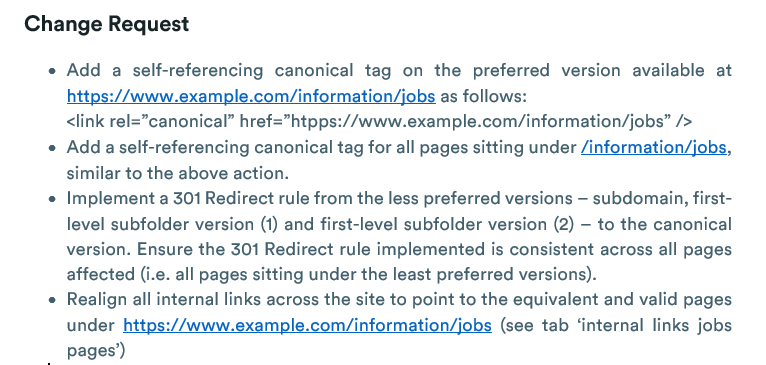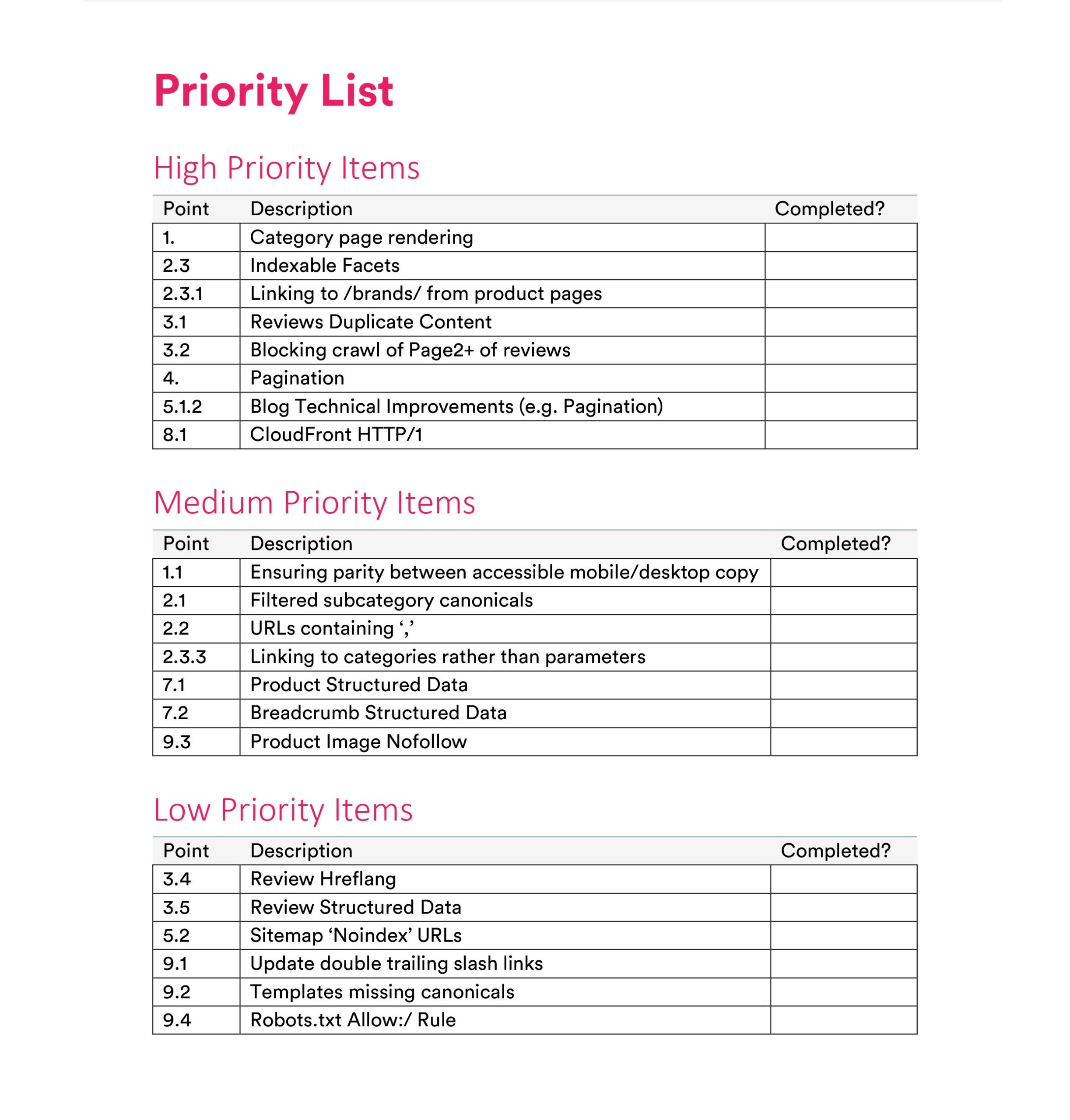How to deliver your SEO recommendations in the most effective way
The way in which you deliver SEO recommendations will determine how and when the developer implements them. In an ideal world, you want this to be as quick as possible and without any errors. Whether it’s a technical audit, site speed audit or a simple technical health check, there are a few things you should keep in mind:
- Give as many details as possible within your recommendations. Explain the context of your recommendations and the reasons why they’re important (what impact or potential benefit you expect to get out of its implementation). At the end of each section, summarise in a few bullet points every change request you are recommending, to ensure the actions to be taken are clear. Here’s an example:

- Where relevant, enrich your recommendations with illustrations of the issues and provide developers with examples. For example, if you’re recommending implementing schema markup, add a snippet of the code required using a real URL as example.
- Remember that you’re not only writing for developers. There’s a high chance this will be seen by other stakeholders and decision makers who don’t have a technical background and they also need to be able to understand your recommendations. To combat this, you could also add screenshots from competitors so that they understand how it would look like from a user perspective.
- In most cases, a single issue will have more than one solution. If you can, avoid presenting every one of them in your document. Give only one solution to the problem (your preferred one) and fight for that one to be implemented. If you provide a few options, you may have a much harder time pushing your preferred one through. Do make sure you’re familiar with the other alternatives too, in case the someone blocks the solution you’ve chosen down and you need a back-up.
- Include a prioritised list of your SEO recommendations and rank them based on impact and difficulty of implementation. There are a few ways in which you can do this: you could have a score of benefit and difficulty next to each recommendation. Something our clients always find very useful is our development checklist sent at the beginning of our audits, where we summarise all recommendations and split them in order of priority.

- The write up document should always be accompanied by a spreadsheet with all the supporting data. Create one tab for each recommendation and arrange them in order of appearance in the document (from highest to lowest priority). Make sure the tabs are referenced in the audit, with the right name and code number (number of section).
- Finally, make sure your recommendations make it to the receiver. Don’t just send an email and hope for the best! People are busy and chances are that your precious audit, which took you days to complete, ends up buried by other emails. Schedule a face-to-face meeting (ideally) or a call with the relevant stakeholders and developers to go through your document. Make sure everyone knows what’s required from them and don’t leave the room until you get the buy-in from relevant stakeholders and developers.
Setting up the tools requires working together
After delivering your recommendations, you’ll still need to keep track of whether they’re being implemented successfully. Here are some things that will help you work together with the dev team:
- Make sure you have access to their ticketing system. This way, when they create the stories for your change requests, you’ll be able to check that they correspond to your requirements and that all your recommendations are in tickets. Make sure you get notifications when there is an update on one of your SEO tickets or when someone mentions you in a comment.
- Create an implementations tracker sheet and upload it to Google Drive. We use this with our clients to keep track of all the recommendations provided and it has been really useful. If you show your client, project manager and/or development team on how to use it, things will go more smoothly. Include details for each recommendation, including ticket number, priority, difficulty of implementation, owner, as well as the date you made the recommendation:
- Once tasks are complete, you can move them to a ‘Complete’ tab. This will be super useful for the next time you have to do a monthly report or give a performance update at a QBR meeting. By going through this list, you’ll be able to attribute performance changes directly to implementations made at the back of your recommendations.
Tip: when this happens, make developers aware of the positive impact as well; they’ll be happy to know that their effort have paid back, and this will enhance your relationship with them, as well as their trust in the value of your recommendations.
Here is a link to an example of spreadsheet we use with our clients. You can replicate this for your own use.
- In some cases, you’ll need to build a business case to push for your SEO suggestions. Applying revenue figures to these will add some pressure on the development team to get things implemented. It’ll be difficult to assign a value to each recommendation separately, but you can group them together and provide a combined value. For example, group recommendations by page template together or provide a combined figure to several speed recommendations using Google’s impact calculator).
Tip: whilst this will help you prioritise tasks against each other, as well as get the buy-in from stakeholders, you should never guarantee these results; this is a forecast after all, so make sure this is clear.
Integration within the development workflow
Don’t expect developers to disrupt how they normally operate to accommodate an SEO recommendation; it’s important that you understand their development methodology and accommodate this as much as possible to them. A few things you can do on this front are:
- Start by finding out how long their sprint cycle is and schedule a call aligned to these sprints. For example, two of my clients run biweekly sprints, so we have a call every other Monday (ahead of their sprint planning) to discuss which SEO items are going to get into the upcoming sprint. This will help prioritise your suggestions correctly as well as help you push for SEO tasks to get into sprints.
- If you’ve built the implementation tracker sheet mentioned in the previous section, now is time for you to use it. Make sure you go through the top priority actions on every call and try to get an update on when they expect to get these implemented. This way, if there are any blockers, you’ll have time to act without causing major delays.
Tip: it’s also important to have direct contact with their project manager or Scrum Master via email as well, to avoid having to go through any intermediaries.
- I mentioned a ticketing system earlier; now is time for you to use this on a regular basis. Respond to any comments and questions on SEO tickets made by developers and closely follow updates on any of your stories. To ensure things are implemented properly, it’s really important that you check implementations once they are completed in staging, before they are deployed. Then, when pushed live, check the live environment again to make sure everything has been released successfully.
- Remember to update the spreadsheet to move any (successfully) completed actions to the ‘Completed’ tab, along with the implementations date so that you can use this in the future to explain performance changes.
Tip: for some clients, we keep track of their on-page changes in a separate tab, too. This way, if rankings fluctuate after some changes in the title or page copy, for example, it’s much easier to know what the cause might be.
Developers are your allies
Developers are people just like you or me, with their own objectives and workloads. Don’t expect them to change their workflows but work around them as much as you can. Doing so should lead to faster implementations, snappy reporting and happy stakeholders and clients.
Hopefully this article has given you some tips on how to achieve this but if you have any questions, please do get in touch. We’ve been there before and would be more than happy to help.
